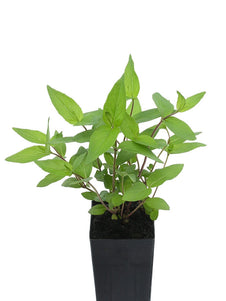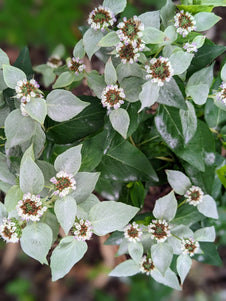







Mint - Stone Mint
Mint - Stone Mint

- In stock, ready to ship
- Inventory on the way

Usually available: All year
Life cycle: Perennial
Height: 30 - 90cm
Position: Sun / part shade
Soil preference: Moist / well drained
This is how we pack and send your Herb Plants to all states except TAS & WA
You will receive
- 1 Stone Mint Herb Plant in a 50 X 75mm tube - General growing instructions
All of our Herb Plants are grown organically with certified organic potting mixes and fertilizers
Botanical Name: Cunila origanoides
Stone Mint is a perennial, evergreen subshrub growing to 30 -60cm and a similar width. Some gardeners report growth of up to 90cm, but this may be including the tall flower stalks. The plant has a generally upright branching habit, with red toned square stems. It may sometimes be slightly prostrate. The dark green leaves are ovate, serrated and positioned oppositely, directly attached to the stem. The leaves and the stems have a fine covering of hairs, although they remain smooth. When crushed, the leaves release a pleasant and pungent aroma similar to both peppermint and oregano, depending on interpretation. Most agree that the aroma is intense and Stone Mint is well worth its place in the garden.
The fragrant, purple or white flowers are tiny and held in clusters at the end of 80cm high branching stalks that extend from the main stem, near the leaf bases. The flowers are two lipped and have long stamens reaching out from the petals. The flowering period is from mid-summer to autumn. When in flower, the whole plant is often much taller than normal. The highly ornamental flowers are often used in arrangements.
This ‘mint’ is not a true mint as it is not in the Genus Mentha, however, Stone Mint is closely related to Oregano, Marjoram and Savoury. It belongs to the Lamiaceae family, also known as the Mint Family. The botanical name, Cunila origanoides refers to the oregano-like leaves of this herb. It may also be called by the scientific synonym Cunila mariana. There are many common names, including Dittany, Hoary Stone Mint, Common Dittany, Feverwort, Gas Plant, Mountain Dittany, Wild Oregano, American Dittany and Sweet Horsemint.Dittany refers to the rocky or stony ground that is Stone Mint’s native habitat in the Eastern United States, where it grows from the north eastern states down to Florida and across to Texas and Oklahoma. This perennial has a long history of cultural use and names have been given to this plant depending on the location and the application in that area. Usually this plant would be found growing in dry open woodlands or thickets, where there is stony or rocky ground.
Cunila origanoides is also called Frost Flower, because it is one of the few plants that produce the curious ‘frost flowers’ when the first frosts of autumn or winter arrive. These frost flowers appear as a result of sap seeping through cracks in long stemmed plants. For this to happen a frost event must occur before the ground has frozen. They may form petal-like features or ribbons of ice around the base of the plant. After the first frost the leaves also turn purple in the natural environment, although this may not happen when grown in Australia.
Growing Conditions
Stone Mint prefers full sun to part shade and does well in dry shady positions. It has medium water requirements and prefers sandy or shallow soils that are well drained. It is important not to overwater Stone Mint or Dittany, as it is known in the United States. This plant is frost tolerant so it may be a good choice for frost prone areas of Australia.
In its native habitat this plant grow on rocky, shallow and dry sandy soils, so replicating this environment will encourage the plant to thrive. However, it will also do well in loamy soils and does have a preference for acidic soil.
This plant may become aggressive in its growth, so container growth may be preferred. After a few years it may become straggly and require replacement or regular pruning for shape. Propagation may be via division or by basal cuttings taken in late spring. However, Stone Mint is also easily grown from seed.
Medicinal Uses
Stone Mint has a strong history of herbal applications including use as an antiseptic, stimulant, to treat fevers and headaches, to stimulate menstruation and perspiration, and as a treatment for snake and insect bites. A peppermint flavoured tea may be made from the leaves or they may be crushed and used directly, for example, on insect bites. One of the most common uses for this plant was also as a digestive aid, particularly for flatulence, gas, bloating, cramps, upset stomach and heartburn.
An essential oil called ‘Oil of Dittany’ or ‘Cunila Oil’ is produced from the leaves of Stone Mint and contains the chemicals thymol, limonene and carvacrol. These active ingredients help with treatment of respiratory conditions, sinus congestion, rheumatoid arthritis, and provide anti-fungal and anti-bacterial treatments for small wounds and infections.
Due to its close relationship to Oregano and Marjoram it shares many of the same medicinal qualities. Stone Mint also contains active chemicals that may induce miscarriage, so pregnant women should avoid this plant.
Culinary Uses
The edible leaves are highly fragrant and even dried leaves and stems retain their scent for long periods. They may be used fresh or dried in any dishes calling for Italian style herbs, or even just on pizza. Native American Indians used to make a strong peppermint flavoured tea, in the same manner as mints are used in Europe.
Other Uses
Large bunches of the plant may be used as insect repellents, for example, they are reputed to keep away large horseflies.
All information provided on this website is for informational purposes only. Please seek professional advice before commencing any treatment.





